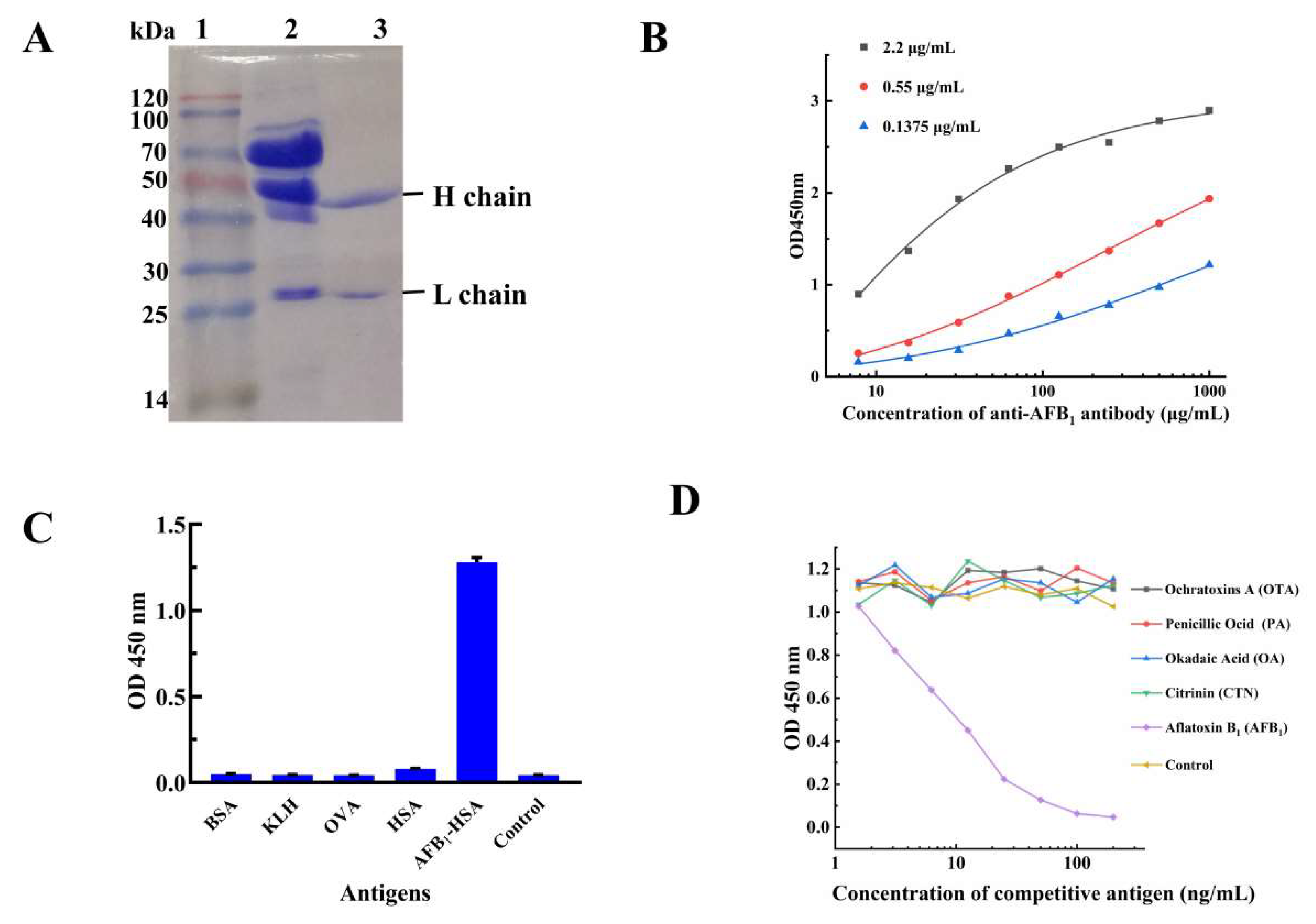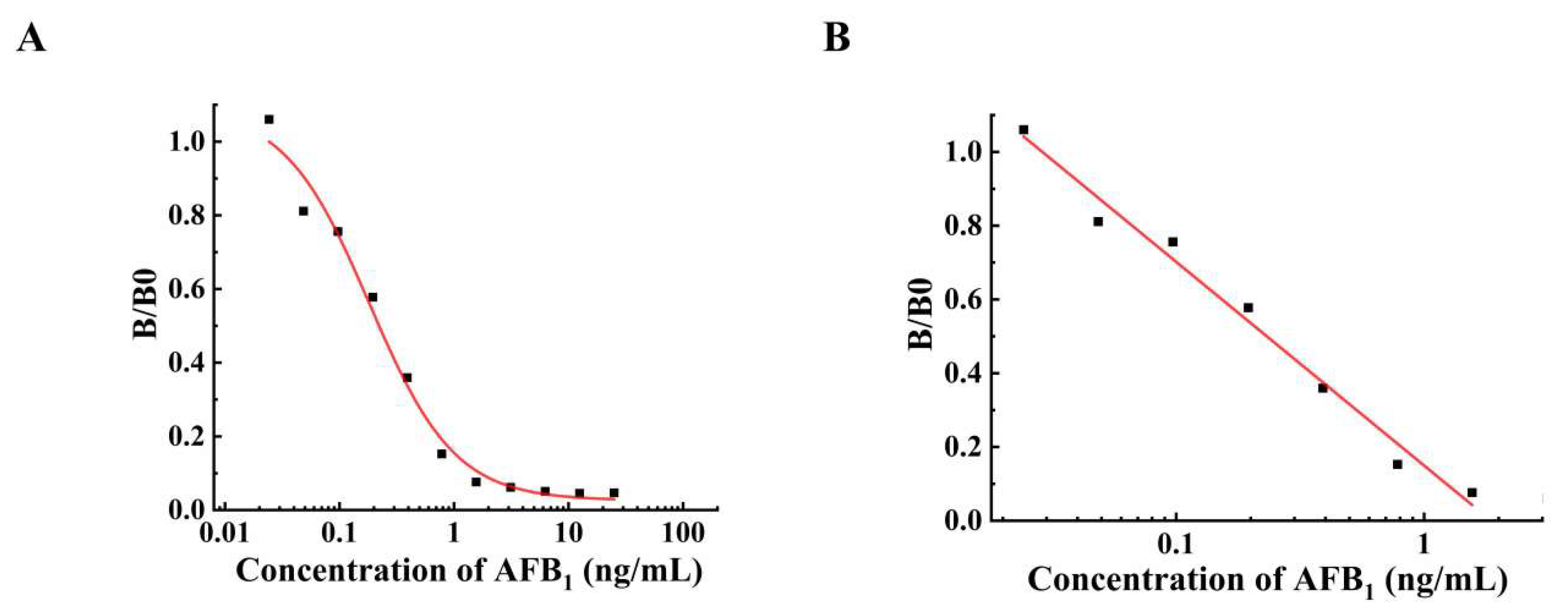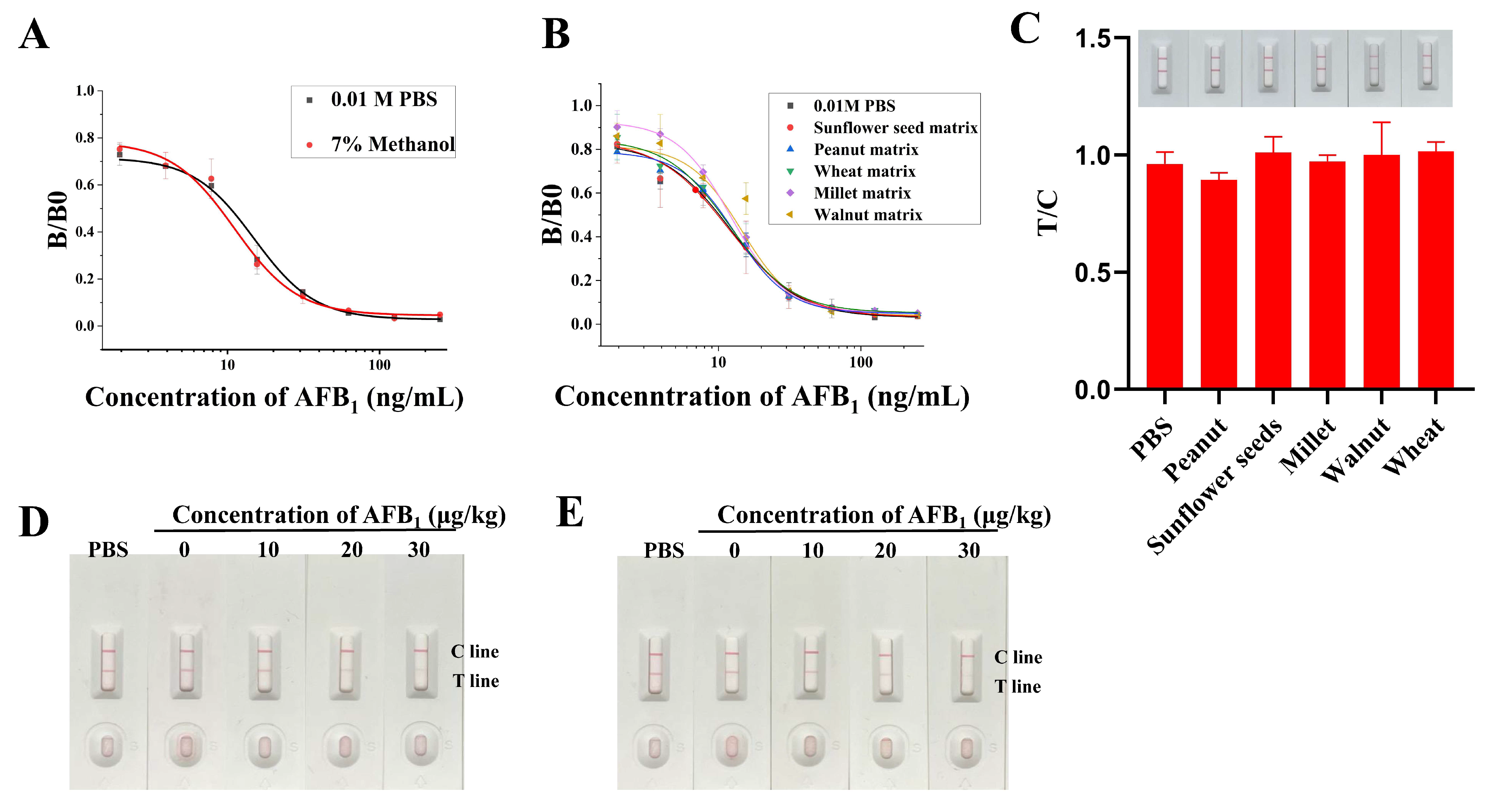Development of Latex Microsphere-Based Immunochromatographic Strips for Detecting Key Aflatoxins
Abstract
1. Introduction
2. Results and Discussion
2.1. Preparationand Identification of Complete Antigen
2.2. Screening of Positive Hybridoma Cell
2.3. Characterization of the mAb from 3A1
2.4. Development of icELISA for Aflatoxin Detection
2.5. The Preparation of the Latex Microspheres (LM) Probe
2.6. Construction of Latex Microsphere-Based Immunochromatographic Test Strip
2.7. Analysis of Spiked Samples
3. Conclusions
4. Materials and Methods
4.1. Material and Reagents
4.2. Preparation of Complete Antigens
4.3. Mice Immunization
4.4. Indirect ELISA (iELISA)
4.5. The Preparation of the Hybridoma Cells
4.6. Preparation of Monoclonal Antibody
4.7. Establishment of the Standard Curve for Detection
4.8. Preparation of Latex Microsphere (LM) Labelled mAb
4.9. Construction of Testing Strip
4.10. Specificity and Sensitivity of the LM-ICTS
4.11. Actual Sample Testing
4.12. Data Analysis
Author Contributions
Funding
Institutional Review Board Statement
Informed Consent Statement
Data Availability Statement
Conflicts of Interest
References
- Blount, W.P. Turkey “X” disease. J. Brit. Turk. Fed. 1961, 9, 52–54. [Google Scholar]
- Williams, J.H.; Phillips, T.D.; Jolly, P.E.; Stiles, J.K.; Jolly, C.M.; Aggarwal, D. Human aflatoxicosis in developing countries: A review of toxicology, exposure, potential health consequences, and interventions. Am. J. Clin. Nutr. 2004, 80, 1106–1122. [Google Scholar] [CrossRef] [PubMed]
- Benkerroum, N. Retrospective and Prospective Look at Aflatoxin Research and Development from a Practical Standpoint. Int. J. Environ. Res. Public Health 2019, 16, 3633. [Google Scholar] [CrossRef]
- Awuchi, C.G.; Ondari, E.N.; Ogbonna, C.U.; Upadhyay, A.K.; Baran, K.; Okpala, C.O.R.; Korzeniowska, M.; Guiné, R.P.F. Mycotoxins Affecting Animals, Foods, Humans, and Plants: Types, Occurrence, Toxicities, Action Mechanisms, Prevention, and Detoxification Strategies—A Revisit. Foods 2021, 10, 1279. [Google Scholar] [CrossRef]
- The U.S. Food and Drug Administration (FDA). Toxins Found in Food Infected by Certain Molds or Fungi. Available online: https://www.fda.gov/food/natural-toxins-food/mycotoxins#Aflatoxins (accessed on 26 September 2024).
- Jaruga, P.; Vartanian, V.L.; Minko, I.G.; Dizdaroglu, M.; Lloyd, R.S. Aflatoxin B1-induced DNA adduct formation in murine kidney and liver. Environ. Toxicol. Pharmacol. 2025, 114, 104647. [Google Scholar] [CrossRef]
- Shimada, T.; Nakamura, S.-I.; Imaoka, S.; Funae, Y. Genotoxic and mutagenic activation of aflatoxin B1 by constitutive forms of cytochrome P-450 in rat liver microsomes. Toxicol. Appl. Pharmacol. 1987, 91, 13–21. [Google Scholar] [CrossRef]
- Sun, H.; He, Z.; Xiong, D.; Long, M. Mechanisms by which microbial enzymes degrade four mycotoxins and application in animal production: A review. Anim. Nutr. 2023, 15, 256–274. [Google Scholar] [CrossRef]
- Ma, L.; Wang, J.; Zhang, Y. Probing the Characterization of the Interaction of Aflatoxins B1 and G1 with Calf Thymus DNA In Vitro. Toxins 2017, 9, 209. [Google Scholar] [CrossRef]
- Benkerroum, N. Chronic and Acute Toxicities of Aflatoxins: Mechanisms of Action. Int. J. Environ. Res. Public Health 2020, 17, 423. [Google Scholar] [CrossRef] [PubMed]
- Ouakhssase, A.; Chahid, A.; Choubbane, H.; Aitmazirt, A.; Addi, E.A. Optimization and validation of a liquid chromatography/tandem mass spectrometry (LC-MS/MS) method for the determination of aflatoxins in maize. Heliyon 2019, 5, e01565. [Google Scholar] [CrossRef]
- Liu, H.-Y.; Lin, S.-L.; Chan, S.-A.; Lin, T.-Y.; Fuh, M.-R. Microfluidic chip-based nano-liquid chromatography tandem mass spectrometry for quantification of aflatoxins in peanut products. Talanta 2013, 113, 76–81. [Google Scholar] [CrossRef]
- Chu, F.S.; Lee, R.C.; Trucksess, M.W.; Park, D.L. Evaluation of enzyme-linked immunosorbent assay of cleanup for thin-layer chromatography of aflatoxin B1 in corn, peanuts, and peanut butter. J. Assoc. Off. Anal. Chem. 1988, 71, 953–956. [Google Scholar]
- Ameen, F.; Al-Masri, A.A. Extraction and determination of aflatoxin B1 in cereal samples using pH-switchable hydrophobic deep eutectic solvents followed by HPLC-FL analysis. Anal. Methods 2023, 15, 3802–3809. [Google Scholar] [CrossRef] [PubMed]
- Zhu, C.; Zhang, G.; Huang, Y.; Yang, S.; Ren, S.; Gao, Z.; Chen, A. Dual-competitive lateral flow aptasensor for detection of aflatoxin B1 in food and feedstuffs. J. Hazard. Mater. 2018, 344, 249–257. [Google Scholar] [CrossRef] [PubMed]
- Ko, J.; Lee, C.; Choo, J. Highly sensitive SERS-based immunoassay of aflatoxin B1 using silica-encapsulated hollow gold nanoparticles. J. Hazard. Mater. 2015, 285, 11–17. [Google Scholar] [CrossRef]
- Yan, T.; Zhang, Z.; Zhang, Q.; Tang, X.; Wang, D.; Hu, X.; Zhang, W.; Chen, X.; Li, P. Simultaneous determination for A. flavus-metabolizing mycotoxins by time-resolved fluorescent microbead or gold-enabling test strip in agricultural products based on monoclonal antibodies. Mikrochim. Acta 2020, 187, 653. [Google Scholar] [CrossRef] [PubMed]
- Tesfaye, A.; Kurtu, M.Y.; Mummed, Y.Y.; Mohammed, A. Aflatoxins Levels in Concentrate Feeds Collected from Specialized Dairy Farms and Local Markets in Selected Urban Centers of Eastern Ethiopia. Toxins 2024, 16, 418. [Google Scholar] [CrossRef]
- Ting, W.T.E.; Chang, C.H.; Szonyi, B.; Gizachew, D. Growth and Aflatoxin B1, B2, G1, and G2 Production by Aspergillus flavus and Aspergillus parasiticus on Ground Flax Seeds (Linum usitatissimum). J. Food Prot. 2020, 83, 975–983. [Google Scholar] [CrossRef]
- Zivoli, R.; Gambacorta, L.; Piemontese, L.; Solfrizzo, M. Reduction of Aflatoxins in Apricot Kernels by Electronic and Manual Color Sorting. Toxins 2016, 8, 26. [Google Scholar] [CrossRef]
- Lei, H.; He, Z.; Yuan, H.; Wu, J.; Wen, L.; Li, R.; Zhang, M.; Yuan, L.; Yuan, Z. Generation and characterization of a monoclonal antibody to penicillic acid from Penicillium cyclopium. Afr. J. Biotechnol. 2010, 9, 3026–3031. [Google Scholar]
- Meloun, B.; Morávek, L.; Kostka, V. Complete amino acid sequence of human serum albumin. FEBS Lett. 1975, 58, 134–137. [Google Scholar] [CrossRef]
- Pouletty, P. Rapid isotyping of mouse monoclonal antibodies. Methods Mol. Biol. 1995, 45, 69–78. [Google Scholar]
- Duhamel, R.C.; Schur, P.H.; Brendel, K.; Meezan, E. pH gradient elution of human IgG1, IgG2 and IgG4 from protein A-sepharose. J. Immunol. Methods 1979, 31, 211–217. [Google Scholar] [CrossRef] [PubMed]
- Fishman, J.B.; Berg, E.A. Protein A and Protein G Purification of Antibodies. Cold Spring Harb. Protoc. 2019, 2019, 82–84. [Google Scholar] [CrossRef] [PubMed]
- Devey, M.E.; Bleasdale, K.; Lee, S.; Rath, S. Determination of the functional affinity of IgG1 and IgG4 antibodies to tetanus toxoid by isotype-specific solid-phase assays. J. Immunol. Methods 1988, 106, 119–125. [Google Scholar] [CrossRef]
- Pritchard, D.I.; Williams, D.J.; Behnke, J.M.; Lee, T.D. The role of IgG1 hypergammaglobulinaemia in immunity to the gastrointestinal nematode Nematospiroides dubius. The immunochemical purification, antigen-specificity and in vivo anti-parasite effect of IgG1 from immune serum. Immunology 1983, 49, 353–365. [Google Scholar]
- Cai, P.; Wang, R.; Ling, S.; Wang, S. A high sensitive platinum-modified colloidal gold immunoassay for tenuazonic acid detection based on monoclonal IgG. Food Chem. 2021, 360, 130021. [Google Scholar] [CrossRef]
- Jiang, J.Y.; Zhang, L.; Qin, L.; Luo, J.Y.; Fu, Y.W.; Qin, J.A.; Wang, C.J.; Ouyang, Z.; Yang, M.H. Preparation of highly sensitive monoclonal antibody against aflatoxin B_1 and its application in rapid detection of contamination in Ziziphi Spinosae Semen. Zhongguo Zhong Yao Za Zhi 2020, 45, 3900–3907. [Google Scholar]
- Lipigorngoson, S.; Limtrakul, P.; Suttajit, M.; Yoshizawa, T. In-house direct cELISA for determining aflatoxin B1 in Thai corn and peanuts. Food Addit. Contam. 2003, 20, 838–845. [Google Scholar] [CrossRef]
- Chu, X.F.; Dou, X.W.; Kong, W.J.; Yang, M.H.; Zhao, C.; Zhao, M.; Ouyang, Z. Contamination level of aflatoxin B1 in lotus seeds rapid screening by indirect competitive ELISA method. Zhongguo Zhong Yao Za Zhi 2015, 40, 704–709. [Google Scholar] [PubMed]
- Akram, Z.; Ayesha, K.; Siddiq, M. Review on Polymer/Carbon Nanotube Composite Focusing Polystyrene Microsphere and Polystyrene Microsphere/Modified CNT Composite: Preparation, Properties, and Significance. Polym.-Plast. Technol. Eng. 2016, 55, 582–603. [Google Scholar] [CrossRef]
- Dávalos-Pantoja, L.; Ortega-Vinuesa, J.L.; Bastos-González, D.; Hidalgo-Álvarez, R. Colloidal stability of IgG- and IgY-coated latex microspheres. Colloids Surf. B Biointerfaces 2001, 20, 165–175. [Google Scholar] [CrossRef]
- Liang, Z.; Peng, T.; Jiao, X.; Zhao, Y.; Xie, J.; Jiang, Y.; Meng, B.; Fang, X.; Yu, X.; Dai, X. Latex Microsphere-Based Bicolor Immunochromatography for Qualitative Detection of Neutralizing Antibody against SARS-CoV-2. Biosensors 2022, 12, 103. [Google Scholar] [CrossRef]
- Faraji, H.; Yazdi, F.T.; Razmi, N. The influence of ultraviolet radiation on aflatoxin producing Aspergillus species’ isolated from Iranian rice. Toxicol. Rep. 2022, 9, 1528–1536. [Google Scholar] [CrossRef]
- Liu, D.; Yu, H.; Luo, S.; Liang, X.; Zhang, Y.; Li, Y.; Sun, J. Aflatoxin contamination and health risk assessment in maize in Gansu Province in 2023. Food Addit. Contam. Part A Chem. Anal. Control Expo. Risk Assess. 2025, 42, 798–806. [Google Scholar] [CrossRef]
- Fakhri, Y.; Vahid, R.; Zahra, P.; Mahboobeh, M.; Amirhossein, M.; Fatemeh, H.; Khaneghah, A.M. The prevalence and concentration of aflatoxins in beers: A global systematic review and meta-analysis and probabilistic health risk assessment. Int. J. Environ. Health Res. 2025, 35, 521–539. [Google Scholar] [CrossRef]
- Alameri, M.M.; Kong, A.S.; Aljaafari, M.N.; Ali, H.A.; Eid, K.; Sallagi, M.A.; Cheng, W.H.; Abushelaibi, A.; Lim, S.E.; Loh, J.Y.; et al. Aflatoxin Contamination: An Overview on Health Issues, Detection and Management Strategies. Toxins 2023, 15, 246. [Google Scholar] [CrossRef]
- Zhao, B.; Xu, Y.; Song, Y.; Zhang, Y.; Lin, L. Food aflatoxin exposure assessment in Sichuan Province, China. Mycotoxin Res. 2023, 39, 261–269. [Google Scholar] [CrossRef] [PubMed]
- Dong, G.; Pan, Y.; Wang, Y.; Ahmed, S.; Liu, Z.; Peng, D.; Yuan, Z. Preparation of a broad-spectrum anti-zearalenone and its primary analogues antibody and its application in an indirect competitive enzyme-linked immunosorbent assay. Food Chem. 2018, 247, 8–15. [Google Scholar] [CrossRef] [PubMed]
- Ling, S.; Zhao, Q.; Iqbal, M.N.; Dong, M.; Li, X.; Lin, M.; Wang, R.; Lei, F.; He, C.; Wang, S. Development of immunoassay methods based on monoclonal antibody and its application in the determination of cadmium ion. J. Hazard. Mater. 2021, 411, 124992. [Google Scholar] [CrossRef] [PubMed]
- Wang, R.; Zhong, Y.; Wang, J.; Yang, H.; Yuan, J.; Wang, S. Development of an ic-ELISA and immunochromatographic strip based on IgG antibody for detection of ω-conotoxin MVIIA. J. Hazard. Mater. 2019, 378, 120510. [Google Scholar] [CrossRef]
- Zhang, W.; Duan, H.; Chen, R.; Ma, T.; Zeng, L.; Leng, Y.; Xiong, Y. Effect of different-sized gold nanoflowers on the detection performance of immunochromatographic assay for human chorionic gonadotropin detection. Talanta 2019, 194, 604–610. [Google Scholar] [CrossRef]
- Ji, Y.; Ren, M.; Li, Y.; Huang, Z.; Shu, M.; Yang, H.; Xiong, Y.; Xu, Y. Detection of aflatoxin B1 with immunochromatographic test strips: Enhanced signal sensitivity using gold nanoflowers. Talanta 2015, 142, 206–212. [Google Scholar] [CrossRef] [PubMed]
- Wang, R.; Zeng, L.; Yang, H.; Zhong, Y.; Wang, J.; Ling, S.; Saeed, A.F.; Yuan, J.; Wang, S. Detection of okadaic acid (OA) using ELISA and colloidal gold immunoassay based on monoclonal antibody. J. Hazard. Mater. 2017, 339, 154–160. [Google Scholar] [CrossRef] [PubMed]
- Huang, Y.; Liu, Y.; Sun, M.; Lu, L.; Li, X.; Jiang, K.; Li, N.; Ling, S.; Wang, S. Establishment of highly sensitive lateral flow immunochromatographic strips for quinclorac detection utilizing signal amplification nanoparticles. Food Chem. 2025, 463, 140960. [Google Scholar] [CrossRef] [PubMed]







| Spiked Level (μg/kg) | Intra-Assay | Inter-Assay | ||||||
|---|---|---|---|---|---|---|---|---|
| n | Measured (μg/kg) | Recovery (%) | CV (%) | n | Measured (μg/kg) | Recovery (%) | CV (%) | |
| 2 | 3 | 1.8 ± 0.1 | 91.0 ± 3.1 | 3.5 | 3 | 1.8 ± 0.0 | 90.7 ± 0.5 | 0.5 |
| 1 | 3 | 1.0 ± 0.0 | 95.8 ± 2.7 | 2.8 | 3 | 0.9 ± 0.1 | 91.3 ± 6.4 | 7.0 |
| 0.5 | 3 | 0.4 ± 0.0 | 85.7 ± 4.9 | 5.9 | 3 | 0.4 ± 0.0 | 84.9 ± 0.2 | 0.2 |
| 0.3 | 3 | 0.2 ± 0.0 | 90.0 ± 2.8 | 3.1 | 3 | 0.2 ± 0.0 | 88.7 ± 1.7 | 1.8 |
| Average | 90.6 ± 3.4 | 3.8 | 88.9 ± 2.2 | 2.4 | ||||
| Sample | Spiked Level (μg/kg) | Intra-Assay | Inter-Assay | ||||||
|---|---|---|---|---|---|---|---|---|---|
| n | Measured (μg/kg) | Recovery (%) | CV (%) | n | Measured (μg/kg) | Recovery (%) | CV (%) | ||
| Peanuts | 10 | 3 | 9.6 ± 0.8 | 96.6 ± 8.3 | 8.6 | 3 | 10.0 ± 0.9 | 102.0 ± 9.6 | 9.4 |
| 20 | 3 | 20.1 ± 0.4 | 100.7 ± 2.1 | 2.1 | 3 | 19.0 ± 1.3 | 96.3 ± 6.5 | 6.7 | |
| 30 | 3 | 29.4 ± 0.7 | 98.1 ± 2.4 | 2.5 | 3 | 23.7 ± 2.0 | 79.6 ± 6.6 | 8.3 | |
| Average | 98.4 ± 4.3 | 4.4 | 92.6 ± 7.6 | 8.1 | |||||
| Sunflower seeds | 10 | 3 | 9.3 ± 1.3 | 101.6 ± 13.8 | 13.5 | 3 | 8.8 ± 0.6 | 88.4 ± 6.4 | 7.2 |
| 20 | 3 | 17.5 ± 0.5 | 87.3 ± 2.7 | 3.1 | 3 | 18.1 ± 0.7 | 90.7 ± 3.6 | 4.0 | |
| 30 | 3 | 28.3 ± 0.9 | 94.3 ± 3.1 | 3.3 | 3 | 26.6 ± 0.9 | 88.6 ± 2.9 | 3.3 | |
| Average | 94.4 ± 7.2 | 6.6 | 89.2 ± 4.3 | 4.9 | |||||
Disclaimer/Publisher’s Note: The statements, opinions and data contained in all publications are solely those of the individual author(s) and contributor(s) and not of MDPI and/or the editor(s). MDPI and/or the editor(s) disclaim responsibility for any injury to people or property resulting from any ideas, methods, instructions or products referred to in the content. |
© 2025 by the authors. Licensee MDPI, Basel, Switzerland. This article is an open access article distributed under the terms and conditions of the Creative Commons Attribution (CC BY) license (https://creativecommons.org/licenses/by/4.0/).
Share and Cite
Wang, J.; Fu, W.; Ma, X.; Chen, L.; Song, W.; Ling, S.; Qian, H.; Wang, S.; Zhuang, Z. Development of Latex Microsphere-Based Immunochromatographic Strips for Detecting Key Aflatoxins. Toxins 2025, 17, 426. https://doi.org/10.3390/toxins17090426
Wang J, Fu W, Ma X, Chen L, Song W, Ling S, Qian H, Wang S, Zhuang Z. Development of Latex Microsphere-Based Immunochromatographic Strips for Detecting Key Aflatoxins. Toxins. 2025; 17(9):426. https://doi.org/10.3390/toxins17090426
Chicago/Turabian StyleWang, Jie, Wangzhuo Fu, Xuezhen Ma, Lin Chen, Weitao Song, Sumei Ling, Hongyun Qian, Shihua Wang, and Zhenhong Zhuang. 2025. "Development of Latex Microsphere-Based Immunochromatographic Strips for Detecting Key Aflatoxins" Toxins 17, no. 9: 426. https://doi.org/10.3390/toxins17090426
APA StyleWang, J., Fu, W., Ma, X., Chen, L., Song, W., Ling, S., Qian, H., Wang, S., & Zhuang, Z. (2025). Development of Latex Microsphere-Based Immunochromatographic Strips for Detecting Key Aflatoxins. Toxins, 17(9), 426. https://doi.org/10.3390/toxins17090426






